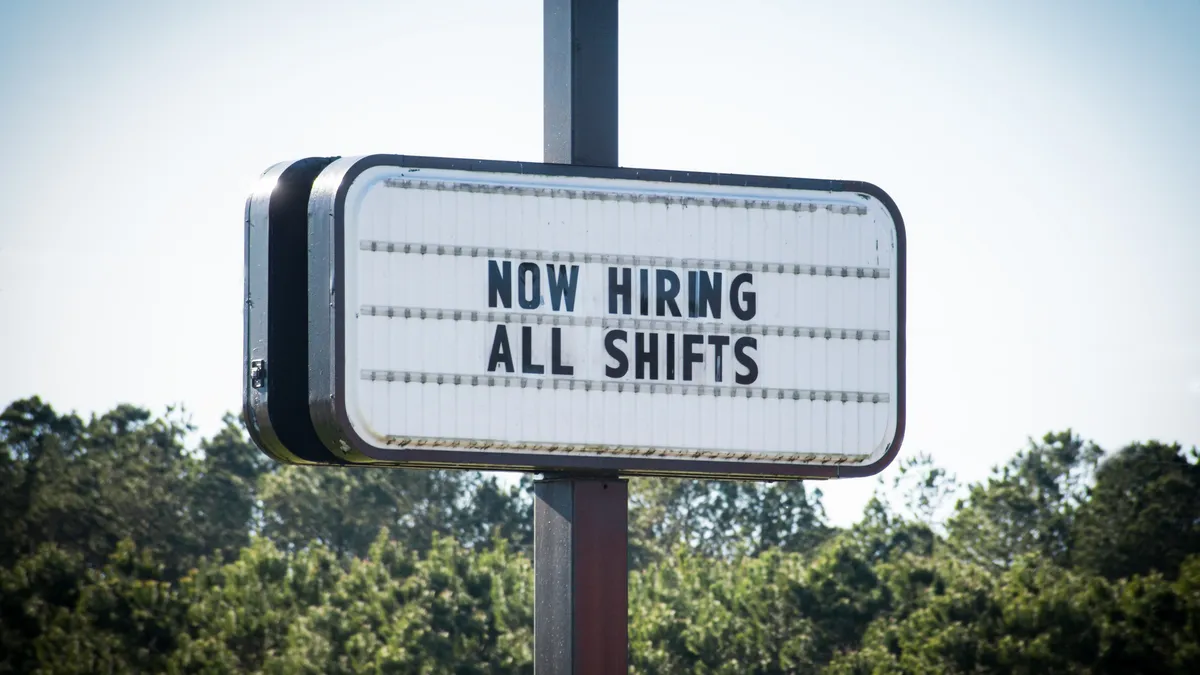Dive Brief:
- Hiring soared last month by 336,000, far exceeding predictions and validating recent signals from Federal Reserve policymakers that they plan to sustain high interest rates for a longer period than forecast in June.
- Payrolls swelled in September more than during any month since January, and well above the average monthly gain of 267,000 during the prior 12 months, the Labor Department said Friday. Job growth in July and August was also revised up by a total of 119,000, and the unemployment rate remained at 3.8%.
- “This report is generally consistent with a ‘higher-for-longer’ monetary policy stance,” Fannie Mae Chief Economist Doug Duncan said Friday in an email.
Dive Insight:
Following the news of robust hiring, traders in interest rate futures trimmed the odds that the Fed will leave the federal funds rate unchanged at the end of a two day meeting on Nov. 1 to 73% from 80%, according to the CME FedWatch Tool. They set odds of a quarter-percentage-point increase at 27%, up from 20% on Thursday.
The Fed last month kept the benchmark interest rate at a range between 5.25% and 5.5%, a 22-year high, while affirming its pledge to corral inflation and signaling that a quarter point hike is possible as early as Nov. 1.
The central bank will likely increase the federal funds rate to 5.6% by December before trimming it to 5.1% by the end of next year, a half point higher than a 4.6% estimate in June, according to median projections by Fed officials released Sept. 20. Policymakers have chosen to keep the main rate unchanged at two of six meetings this year.
The Fed has slowed inflation during the past year by tightening monetary policy more aggressively than any time in four decades.
The central bank’s preferred inflation gauge — the core personal consumption expenditures price index excluding volatile food and energy — declined in August to 3.9% on an annual basis from a peak of 5.4% in February 2022.
The 0.1% increase in August compared with July was the lowest month-on-month change since November 2020.
“Ultimately, the Fed cares about inflation, not payroll growth per se, so decent job growth coupled with falling inflation will do just fine,” Pantheon Macroeconomics Chief Economist Ian Shepherdson said Friday in an email to clients.
Yet the Fed has far to go before reaching its 2% inflation target. Policymakers in coming months may end up tightening too much after having described rising inflation in 2021 as transitory, holding interest rates at around zero and allowing price pressures to surge, economists said.
Borrowers and investors face the risk “that policymakers are still burned by the ‘transitory’ experience and are unwilling to believe that the data showing they are on course for what they want, without further rate hikes,” Shepherdson said.
“We think the Fed will not hike again, but it is a much closer call than we would like,” he said.
The jobs report — along with unexpectedly strong economic growth and the Fed plan to sustain high borrowing costs — prompted bond traders on Friday to push up the yield on the benchmark 10-year Treasury note to the highest level since July 2007.
The 10-year Treasury yield, while easing later Friday to about 4.8%, still remained a percentage point higher than at the start of July. The yield is the benchmark for corporate bonds, auto loans, mortgages, student loans and other financing.
Rising yields since the Sept. 19-20 Fed meeting have reinforced the central bank’s fight against inflation, San Francisco Fed President Mary Daly said Thursday.
With yields increasing, “the need to do tightening additionally is not there,” Daly said. “If financial conditions are sufficiently tight, our work is not necessary, because we don't need to boost them more.”
Daly noted a “general understanding now that we are committed at the FOMC [Federal Open Market Committee] to keeping rates higher for longer in an effort to bring inflation fully back down to 2%,” she said.
“I see that as a positive outcome — that we would have tighter financial conditions — because then we can really get the job done at putting inflation back to rest,” she said.
Slowing wage growth also argues against additional rate hikes. Average hourly earnings in September rose a lower-than-expected 0.2%, or 4.2% year-over-year, the Labor Department said Friday.















